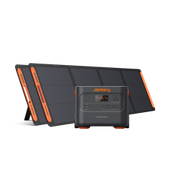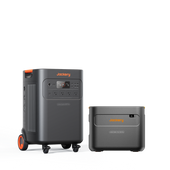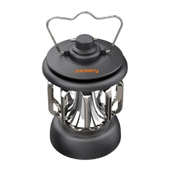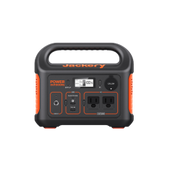If you live in an RV, a camper, or a cabin, solar energy with battery storage is an excellent way to meet your energy requirements. After selecting your solar panel system, you must purchase a battery to store the energy the panels generate.
In the past, you were required to have access to electrical power to recharge your 12V battery. With solar panels, you can now live off-grid and recharge your battery. However, getting the battery charged takes more than just hooking up solar panels and a 12V battery. There are various Amp-hour 12V batteries, and different types of batteries may require solar panels with varied wattages.
This comprehensive guide to using solar panels to charge a 12V battery covers everything you need to know, including why you should use solar panels to charge a battery, what size of solar panel, how many solar panels, and how to charge a 12V battery. We strongly suggest Jackery Solar Panels with varying power output to meet your requirements. Alternatively, you can combine solar panels with our Portable Power Stations to maximize solar energy.
Why Choose Solar Panel to Charge A 12V Battery?
Solar panels use the solar energy to convert photovoltaic energy into usable electricity. Because the sun rises each morning to provide all thermal energy, these systems are renewable and inexhaustible.
Consequently, no harm is caused to the contemporary environment. Additionally, limited and valuable energy resources are preserved for future generations. Therefore, the solar energy system is sustainable and environmentally beneficial.
Using it to restore a battery's healthy charge is eco-friendly. It is your contribution to creating a better planet.
In addition, solar panels reduce reliance on the primary power grid. Most of your electricity comes from the sun, accessible to everyone. It reduces your electricity costs and saves you a great deal of money.
What Size of Solar Panel Needed to Charge A 12V Battery?
Whether camping, traveling in an RV, or cruising the open seas in a boat, you'll likely need a 12V battery. Given the information above, using a solar panel to charge a 12V battery is more sustainable and cost-effective.
You must know the different types of 12V batteries and their Amp-Hour (Ah) ratings to calculate what size solar panel you need to charge your 12V battery.
- Amp-Hour: An amp hour is a unit of measurement used to describe the amount of amperage a battery can deliver in one hour.
- Peak Sun Hour: One peak sun hour occurs when the sun's intensity reaches an average of 1,000 volts per square meter of photovoltaic power.
- Solar Charge Controller: A solar charge controller protects a battery from being overcharged by regulating the voltage and current that travel from the solar panel to the battery.
- Battery Depth of Discharge: It indicates the proportion of the battery discharged about its total capacity.
What Are The Types of 12V Batteries?
Using the proper batteries significantly impacts your equipment's overall efficacy and longevity. And various battery types will require different solar panel sizes for charging.
Lithium Battery: A lithium battery is a rechargeable type that takes advantage of the unique properties of lithium, the lightest of all metals. Lithium batteries contain lithium metal as the anode material. Compared to other batteries, they are distinctive due to their high unit cost and energy density.
Lead-Acid Battery: Rechargeable batteries made from lead and sulfuric acid are known as lead-acid batteries. The information is submerged in sulfuric acid to enable a controlled chemical reaction. This chemical reaction is responsible for the battery's ability to generate electricity. The response is then reversed to recharge the battery.
Deep Cycle Battery: It is made to provide constant power for a long time. Deep cycle batteries may be exhausted up to 80%, but most manufacturers advise against discharging them below 45%. Regularly exceeding this limit will reduce the battery's lifespan.
What Size of Solar Panel to Charge A 12V 50Ah Battery?
Understanding amp hours is one of the most crucial stages in determining the solar panel requirements for a particular battery. The capacity of a battery to supply electrical current for one hour is measured in amp hours. Therefore, a 50Ah battery can deliver 50Amps for one hour.
Check what size of solar panel to charge a 12V 50Ah battery in the following table:
|
12V 50Ah Battery |
Charge Controller |
Charging Time |
Solar Panel Size |
|
Lithium Battery |
MPPT |
5 Peak Sun Hours |
150W |
|
Lithium Battery |
MPPT |
10 Peak Sun Hours |
80W |
|
Lithium Battery |
MPPT |
15 Peak Sun Hours |
60W |
|
Lithium Battery |
MPPT |
20 Peak Sun Hours |
50W |
|
Lithium Battery |
PWM |
5 Peak Sun Hours |
200W |
|
Lithium Battery |
PWM |
10 Peak Sun Hours |
100W |
|
Lithium Battery |
PWM |
15 Peak Sun Hours |
70W |
|
Lithium Battery |
PWM |
20 Peak Sun Hours |
40W |
Data Source: Foot Print Hero
With an MPPT charge controller, you would need a 50-watt solar panel to charge a 12V 50Ah lithium battery from a depth of discharge of 100 percent in 20 hours of optimal sunlight. Using a PWM charge controller and a solar panel of 40 watts, you can charge a 12V 50Ah lithium battery from a depth of discharge of 100 percent in 20 hours of optimal sunlight.
|
12V 50Ah Battery |
Charge Controller |
Charging Time |
Solar Panel Size |
|
Lead-Acid Battery |
MPPT |
5 Peak Sun Hours |
120W |
|
Lead-Acid Battery |
MPPT |
10 Peak Sun Hours |
60W |
|
Lead-Acid Battery |
MPPT |
15 Peak Sun Hours |
40W |
|
Lead-Acid Battery |
MPPT |
20 Peak Sun Hours |
30W |
|
Lead-Acid Battery |
PWM |
5 Peak Sun Hours |
140W |
|
Lead-Acid Battery |
PWM |
10 Peak Sun Hours |
70W |
|
Lead-Acid Battery |
PWM |
15 Peak Sun Hours |
40W |
|
Lead-Acid Battery |
PWM |
20 Peak Sun Hours |
30W |
Data Source: Foot Print Hero
When replacing the lithium battery with a lead-acid battery, you can observe that the solar panel power is diminished. A 12V 50Ah lead acid battery could be charged from 50% depth of discharge to the full in 5 hours of ideal sunlight using a 120W solar panel and an MPPT charge controller.
What Size of Solar Panel to Charge A 12V 100Ah Battery?
The table below explains what size solar panel is required to charge a 12V 100Ah lithium battery.
With an MPPT charge controller, you would need approximately 300 watts of solar panels to recharge a 12V 100Ah lithium battery from a 100% depth of discharge in five hours of optimal sunlight. With a PWM charge controller and 380 watts of solar panels, you can charge a 12V 100Ah lithium battery from a depth of discharge of 100 percent in five hours of optimal sunlight.
|
12V 100Ah Battery |
Charge Controller |
Charging Time |
Solar Panel Size |
|
Lithium Battery |
MPPT |
5 Peak Sun Hours |
300W |
|
Lithium Battery |
MPPT |
10 Peak Sun Hours |
160W |
|
Lithium Battery |
MPPT |
15 Peak Sun Hours |
110W |
|
Lithium Battery |
MPPT |
20 Peak Sun Hours |
80W |
|
Lithium Battery |
PWM |
5 Peak Sun Hours |
380W |
|
Lithium Battery |
PWM |
10 Peak Sun Hours |
190W |
|
Lithium Battery |
PWM |
15 Peak Sun Hours |
130W |
|
Lithium Battery |
PWM |
20 Peak Sun Hours |
100W |
Data Source: Foot Print Hero
To fully recharge a 12V 100Ah lead acid battery from 50% drain depth in 5 hours of ideal sunlight using an MPPT charge controller, you require roughly 230 watts of solar panels.
A 12V 100Ah lead acid battery could be charged from 50% depth of discharge to 100% in five hours of ideal sunlight using a PWM charge controller and around 260 watts of solar panels.
|
12V 100Ah Battery |
Charge Controller |
Charging Time |
Solar Panel Size |
|
Lead-Acid Battery |
MPPT |
5 Peak Sun Hours |
230W |
|
Lead-Acid Battery |
MPPT |
10 Peak Sun Hours |
100W |
|
Lead-Acid Battery |
MPPT |
15 Peak Sun Hours |
70W |
|
Lead-Acid Battery |
MPPT |
20 Peak Sun Hours |
50W |
|
Lead-Acid Battery |
PWM |
5 Peak Sun Hours |
260W |
|
Lead-Acid Battery |
PWM |
10 Peak Sun Hours |
120W |
|
Lead-Acid Battery |
PWM |
15 Peak Sun Hours |
80W |
|
Lead-Acid Battery |
PWM |
20 Peak Sun Hours |
60W |
Data Source: Foot Print Hero
What Size of Solar Panel to Charge A 12V 200Ah Battery?
The most common battery worldwide is a 12V, 200Ah unit comprising 6*2V solar cells with End of Discharge. The voltage per cell varies between 1.75 V and 1.8 V. The table below explains what size solar panel to charge a 12V 200Ah lithium battery.
|
12V 200Ah Battery |
Charge Controller |
Charging Time |
Solar Panel Size |
|
Lithium Battery |
MPPT |
5 Peak Sun Hours |
600W |
|
Lithium Battery |
MPPT |
10 Peak Sun Hours |
300W |
|
Lithium Battery |
MPPT |
15 Peak Sun Hours |
200W |
|
Lithium Battery |
MPPT |
20 Peak Sun Hours |
150W |
|
Lithium Battery |
PWM |
5 Peak Sun Hours |
750W |
|
Lithium Battery |
PWM |
10 Peak Sun Hours |
380W |
|
Lithium Battery |
PWM |
15 Peak Sun Hours |
180W |
|
Lithium Battery |
PWM |
20 Peak Sun Hours |
150W |
Data Source: Foot Print Hero
With an MPPT charge controller and 600 watts of solar panels, a 12V 200Ah lithium battery can be charged from a depth of discharge of 100 percent in five hours of optimal sunlight. In contrast, you would need approximately 750 watts of solar panels and a PWM charge controller to recharge a 12V 200Ah lithium battery from a depth of discharge of 100 percent in five hours of optimal sunlight.
|
12V 100Ah Battery |
Charge Controller |
Charging Time |
Solar Panel Size |
|
Lead-Acid Battery |
MPPT |
5 Peak Sun Hours |
440W |
|
Lead-Acid Battery |
MPPT |
10 Peak Sun Hours |
200W |
|
Lead-Acid Battery |
MPPT |
15 Peak Sun Hours |
150W |
|
Lead-Acid Battery |
MPPT |
20 Peak Sun Hours |
100W |
|
Lead-Acid Battery |
PWM |
5 Peak Sun Hours |
540W |
|
Lead-Acid Battery |
PWM |
10 Peak Sun Hours |
230W |
|
Lead-Acid Battery |
PWM |
15 Peak Sun Hours |
160W |
|
Lead-Acid Battery |
PWM |
20 Peak Sun Hours |
120W |
Data Source: Foot Print Hero
To fully recharge a 12V 200Ah lead acid battery from a depth of discharge of 50 percent using solar panels, an MPPT charge controller would require around 440 watts of power from the solar panels. It would take five hours of direct sunlight. And a 540 watts solar panel with a PWM charge controller for charging a lead-acid battery.
How Many Solar Panels Needed to Charge A 12V Battery?
When people examine batteries, they frequently want to know all the minute details, such as how many watt-hours they can expect to use. Knowing wattages can help you determine when you will need a new battery or if you have enough power to charge specific items.
What is the wattage of a 12V battery? It depends on how many Amp-hours the battery maintains. According to the formula for wattage:
Wattage = Volts x Amps
For instance, if you have a 12V battery with 50A capacity, you could calculate the wattage: 12V * 50A = 600W battery capacity. The 100A battery will have 1200W, while the 200A battery will have 2400W.
Jackery is the leading manufacturer of solar products, such as solar panels, portable power stations, and solar generators. There are three varieties of solar panels with outputs of 200W, 100W, and 80W. Continue reading to learn how many solar panels are needed to charge a 12V battery.
Consider Jackery Solar Panels with Portable Power Stations if you need help locating the right solar panels for a battery, charge controller, and inverter to use solar energy effectively.
Jackery SolarSaga 200W Solar Panel
The maximum solar conversion efficiency of Jackery SolarSaga 200W Solar Panel is 24.3 percent. It is foldable, transportable, and instantaneously connected to a power station, making it the ideal solar power system.
With a power rating 200W, it offers the quickest solar charging experience among Jackery's current selection of solar panels. It has adjustable supports and is constructed with monocrystalline solar cells and a honeycomb light-trapping design, making it portable and easy to use. With its adjustable kickstands, the solar panel can absorb the maximum sunlight and be set up in under a minute. It is a must-have for any camping trip or other outdoor adventure.

To charge a 12V battery, various Amps of batteries must be identified. For instance, 4*SolarSaga 200W solar panels and an Explorer 3000 Pro are required to maintain 12V 50Ah, 100Ah, and 200Ah batteries for 4, 2, and 1 hour, respectively.
Product Specs
- Power Rating: 200W
- Materials: Monocrystalline silicon solar cells
- Waterproof: IP68
- Solar Power: Power voltage 18V; power current 11.12A; open circuit voltage 23.2V; short circuit current 11.76A
- Dimensions: Folded 21,2 x 24,2 x 1,6 in (540 x 615 x 40 mm); unfolded 21,2 x 91,3 x 1 in (540 x 2320 x 25 mm); weight 17.5±5lbs(8.0±0.3Kg)
|
Compatible With |
Capacity |
No. of Panels |
Recharging Time |
|
Explorer 2000 Plus |
2042.8Wh |
6 |
4.5 - 5.5H |
|
4 |
6 - 7H |
||
|
3 |
8 - 9.5H |
||
|
2 |
11 - 13H |
||
|
1 |
19 - 22.5H |
||
|
Explorer 5000 Plus |
5040Wh |
6 |
9 - 12H |
|
4 |
14 - 17.5H |
||
|
3 |
21 - 26H |
||
|
2 |
28 - 35H |
||
|
1 |
56 - 70H |
*Learn more details from our product page.
Jackery SolarSaga 100W Solar Panel
In addition to its high % solar conversion efficiency of 24.3%, the Jackery SolarSaga 100W is ideal for outdoor activities and power disruptions. The ETFE-laminated case extends the solar panel's lifespan and weighs only 10.33 lb. It is compact, lightweight, IP68 waterproof-rated, and simple to transport for off-grid adventures.
The Jackery SolarSaga 100W solar panel contains one USB-C (5V,3A) output connector and one USB-A (5V, 2.4A) output port, allowing it to directly charge two small devices simultaneously. These items include phones and fans. Solar energy provides instant and convenient power to your indoor and outdoor appliances!

Check the accompanying table to determine how many 100W solar panels are needed to charge a 12V battery. For instance, six SolarSaga 100W solar panels coupled with an Explorer 3000 Pro can have a capacity of 4590Wh, maintaining a 12V battery operational for 6.5, 3.2, and 1.6 hours, respectively.
Product Specs
- Power Rating: 100W
- Materials: Monocrystalline silicon solar cells
- Waterproof: IP68
- Solar Power: Power voltage 18V; power current 5.55A; open circuit voltage 21.6V; short circuit current 6A
- Dimensions: Folded 24 x 21 x 1.4 in (610 x 535 x 35 mm); unfolded 48 x 21 x 0.2 in (1220 x 535 x 5 mm); weight 10.33 lbs (4.69 kg)
|
Compatible With |
Capacity |
No. of Panels |
Recharging Time |
|
Explorer 2000 Plus |
2042.8Wh |
6 |
1.6 - 2H |
|
4 |
3 - 3.8H |
||
|
3 |
3.8 - 4.8H |
||
|
2 |
6 - 7H |
||
|
1 |
11.5 - 14H |
||
|
Explorer 5000 Plus |
5040Wh |
6 |
4.5 - 5.5H |
|
4 |
7 - 9H |
||
|
3 |
9 - 11.5H |
||
|
2 |
14 - 17.5H |
||
|
1 |
28 - 34H |
*Learn more details from our product page.
Jackery SolarSaga 500X Solar Panels
The Jackery SolarSaga 500X Solar Panels have a high power output and can quickly charge the portable power station. It has a solar conversion efficiency of 25% and is IP68-rated for high outdoor durability. It has a foldable and portable design for easy transport and installation. You can pair the dual-sided solar panels with the Jackery Explorer 5000 Plus Portable Power Station to build a whole-home solar-powered generator for a tiny home.
|
Compatible With |
Capacity |
No. of Panels |
Recharging Time |
|
Explorer 5000 Plus |
5040Wh |
2 |
6.5 - 8.5H |
|
1 |
13 - 17H |
*Learn more details from our product page.
How to Use Solar Panels to Charge A 12V Battery?
Solar battery charging is an excellent method to utilize clean, renewable energy. There are multiple methods to charge a 12V battery with a solar panel.
Method 1: Using Jackery Solar Generator to Charge
Before beginning, you must install a charge controller regulating the voltage transferred from the solar panel to the battery. On sunny days, if the solar panel produces more energy than the battery can manage, the battery may be damaged.
A solar generator, on the other hand, integrates solar panels with a power station, eliminating the need to locate components such as a charge controller and an inverter. In addition, Jackery Solar Generators are simple to use; solar power can be utilized in a matter of minutes.
- Step 1: Using parallel and series methods to connect Jackery Solar Panels with cables;
- Step 2: Using a solar connector to connect Jackery Solar Panels to a Jackery Portable Power Station;
- Step 3: An Explorer portable power station has multiple input and output ports, allowing you to charge your battery and many other devices.

Method 2: Using Charge Controller to Charge
More than connecting the solar panels to the terminals is required to charge a 12V battery. It is not possible to directly charge a 12V battery with photovoltaic panels. To connect solar panels, you'll need the following equipment and components:
- Solar Panels
- Solar Charge Controller
- Solar Cables
- Charge Controller Cables
By controlling how much power is sent from the solar panels to the battery, the charge controller prevents the battery from being overcharged, which can be harmful or even deadly.
- Step 1: Verify that the 12V battery contains conductors. If not, you must acquire 10- or 16-gauge conductors to connect them to the charge controller.
- Step 2: Connect the solar panel's negative cable to the provided adaptor cable. Perform the same operation with the positive panel cable. Connect the positive solar input cable to the controller's positive solar PV terminal and secure the terminal. Repeat this procedure for the solar cable's negative input.
- Step 3: After you've hooked everything up, ensure everything works by turning on the battery and the power. Charge controllers and batteries should be connected when the charge controller turns on.
- Step 4: You must install your solar panels in the optimal orientation to maximize light exposure.
Final Thoughts
If you intend to run a completely off-grid solar power system, or if you want to use solar energy to meet some or all of your power requirements while RVing or camping, knowing what type of solar panels you will need to charge your batteries is extremely helpful.
If you want to learn more about charging a standard 12V battery with clean and eco-friendly solar energy, you've come to the correct place. This article explains the size of solar panels to charge a 12V battery, two methods to charge a 12V battery with solar panels, and how many solar panels are needed. In addition, Jackery Solar Panels with power ratings between 40W and 500W ensure ultra-fast solar charging, particularly when paired with Jackery Portable Power Stations.








































![[Add - on] Jackery Manual Transfer Switch for Explorer 5000 Plus - Jackery](http://www.jackery.com/cdn/shop/files/add-on-jackery-manual-transfer-switch-for-explorer-5000-plus-9017324.png?v=1754016782&width=170)


















































































![What Size of Solar Panel Needed to Charge A 12V Battery [How Many Solar Panels to Charge]](http://www.jackery.com/cdn/shop/articles/what-size-of-solar-panel-needed-to-charge-a-12v-battery-how-many-solar-panels-to-charge-4740159.png?v=1754017571)







24 v 24 WATTS CONSUMED DAILY 7DAYS BACK UP SOLAR PANEL AND BATERY REQUIRED
Leave a comment